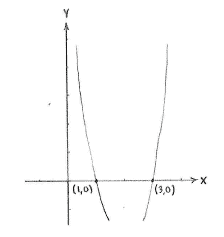Lösung 2.3:9c
Aus Online Mathematik Brückenkurs 1
(Unterschied zwischen Versionen)
K (hat „Solution 2.3:9c“ nach „Lösung 2.3:9c“ verschoben: Robot: moved page) |
|||
| Zeile 1: | Zeile 1: | ||
| - | + | Um die Schnittpunkte zwischen der Funktion <math>y=3x^{2}-12x+9</math> und der ''x''-Achse, lösen wir die Gleichung | |
{{Abgesetzte Formel||<math>0 = 3x^{2}-12x+9\,\textrm{.}</math>}} | {{Abgesetzte Formel||<math>0 = 3x^{2}-12x+9\,\textrm{.}</math>}} | ||
| - | + | Wir dividieren durch 3 und benutzen quadratische Ergänzung | |
{{Abgesetzte Formel||<math>x^{2}-4x+3 = (x-2)^{2} - 2^{2} + 3 = (x-2)^{2} - 1</math>}} | {{Abgesetzte Formel||<math>x^{2}-4x+3 = (x-2)^{2} - 2^{2} + 3 = (x-2)^{2} - 1</math>}} | ||
| - | + | Also hat die Gleichung die Lösungen <math>x=2\pm 1,</math>, oder <math>x=2-1=1</math> and <math>x=2+1=3\,</math>. | |
| - | + | ||
| - | + | Die Schnittpunkte sind also (1,0) und (3,0). | |
[[Image:2_3_9_c.gif|center]] | [[Image:2_3_9_c.gif|center]] | ||
Version vom 20:26, 16. Mär. 2009
Um die Schnittpunkte zwischen der Funktion \displaystyle y=3x^{2}-12x+9 und der x-Achse, lösen wir die Gleichung
| \displaystyle 0 = 3x^{2}-12x+9\,\textrm{.} |
Wir dividieren durch 3 und benutzen quadratische Ergänzung
| \displaystyle x^{2}-4x+3 = (x-2)^{2} - 2^{2} + 3 = (x-2)^{2} - 1 |
Also hat die Gleichung die Lösungen \displaystyle x=2\pm 1,, oder \displaystyle x=2-1=1 and \displaystyle x=2+1=3\,.
Die Schnittpunkte sind also (1,0) und (3,0).

